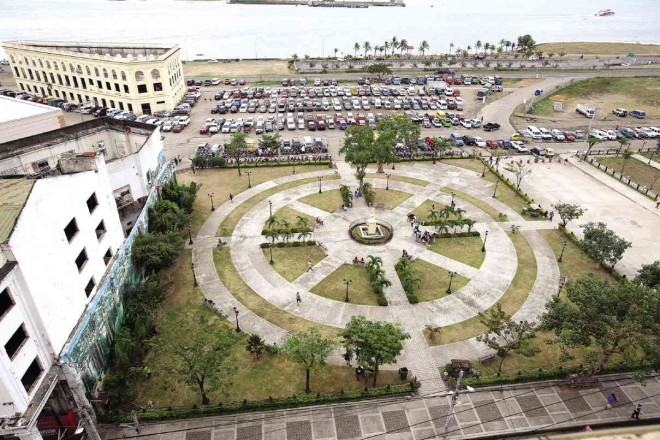Court asked to stop city control of port property

AN AERIAL view of the Senior Citizens Park and the Compania Maritima old building (top left) JUNJIE MENDOZA/CEBU DAILY NEWS
CEBU CITY—The national government has asked the court to stop the city government from taking full control of the Compania Maritima property which includes a prewar building that has become a prominent landmark near the east coast of the South Road Properties.
A petition for injunction with a prayer of temporary restraining order was filed against the city government last week at the Regional Trial Court.
The Cebu Port Authority (CPA) acted as representative of the national government in the civil case that asked the court to stop Mayor Michael Rama and other city officials from exercising ownership rights over Compania Maritima.
The national government also asked the court to nullify the tax declaration used by the city government to claim ownership over the property.
Impleaded in the case were Rama and Acting Cebu City Assessor Eustaquio Cesa.
Article continues after this advertisementCompania Maritima is across the Cebu City Hall and can be recognized by its distinct features—arched windows, ornamental beams and sculptured balusters on its roof-decks.
Article continues after this advertisementThe three-story structure was constructed out of poured concrete in 1910 on a reclaimed land at the port area.
It was known as the Fernandez Building before it was occupied by the Shamrock Hotel during the prewar years. It was eventually leased to house Compania Maritima’s corporate offices.
Since then, the Philippine Ports Authority (PPA) and later the CPA operated Compania Maritima, until Rama, in June 2012, caused the demolition of the concrete fence surrounding the building to give people at the adjacent Senior Citizens Park a better view of the sea.
To secure the premises of Compania Maritima from squatters, the CPA, which operates and maintains port facilities in the city and province of Cebu, restored portions of the concrete fence along P. Burgos and Lapu-Lapu streets.
The CPA doesn’t need to secure a building permit because it has a power to control or supervise any construction of structures inside the port district.
But the city government, through the Office of the Building Official, sent them a Notice of Violation for restoring a part of the concrete fence around Compania Maritima.
The CPA appealed the order but Rama ordered the immediate removal of the fence and interlink wires on June 21, 2013.
The premises of Compania Maritima was then converted into a parking lot for the general public and employees of the Cebu City Hall.
Rama also announced his plans to convert Compania Maritima into a maritime museum, claiming ownership of the Compania Maritima premises.
Cesa issued a tax declaration certificate to prove that the city government owns the property.
But the CPA said the action of the city government was illegal and contradicted the actions of previous local officials on the property.
The CPA pointed out that the city government used to ask CPA’s permission if it wanted to use the Compania Maritima premises where the city installed temporary shelters for pilgrims during the Sinulog.
The CPA said it could not understand why the city was now claiming ownership of the premises of Compania Maritima.
Office of the Solicitor General (OSG), which represented CPA, stressed that Compania Maritima and its premises, being part of the Baseport of Cebu, is by law, owned by the Republic of the Philippines, and placed under the possession and administration of the CPA.
While the premises of Compania Maritima premises are currently not used for ship docking operations, they said it does not make it the property of the city government.
“The intended public use for the Compania Maritima lot as part and parcel of the Baseport of Cebu has remained unchanged—for port operations in the region. It was then, and is still now, a property of public dominion,” the OSG said.